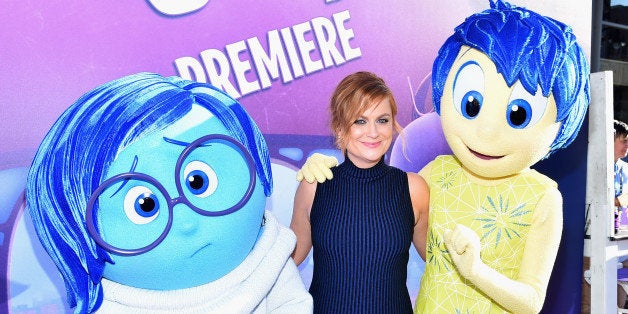
My wife makes fun of me when we watch Pixar movies, because whenever I see Up or the Toy Story trilogy or Monsters, Inc., I need tissues handy at the end -- even if it's the 12th time I've seen it. So when I went to see Pixar's latest movie, Inside Out, I brought my tissues, and I definitely needed them. Yet what made this movie unique is that it also helped me understand why I laugh and cry...and why I often do it at the same time.
The story of Inside Out mostly takes place inside the mind of 11-year-old Riley as she navigates a difficult move from Minnesota to San Francisco. The main characters are Riley's emotions -- Joy, Sadness, Disgust, Anger and Fear -- which guide her decisions and often compete with one another for control of her brain.
One of the biggest challenges that faced Pete Docter, the director, was how to portray abstract emotions in a concrete, visual way. And there's something rather interesting about how the five emotions appear.
Fear is tall, thin, looks like a frayed nerve and is purple. Not only that, his eyes are purple, too. Anger, which looks like a brick and is red (and sometimes flaming), has red eyes. Disgust, who is green, has green eyes. Sadness, not surprisingly, is completely blue, and even looks like a teardrop.
But Joy, who is mainly yellow, has more than one color in her. She has blue eyes and blue hair. Why?
Well, if blue represents sadness, then the message is clear: there is no such thing as "pure joy." Instead, even in our most joyous times, there is often sadness mixed in.
In fact, that's a very Jewish idea. After all, one of the most joyous moments we can experience is a wedding, but it ends with the breaking of a glass to remind us of the destruction of the Temple and that our world is still broken. In other words, even at our highest moments, there is always a little sadness in there.
But the comfort is that reverse is often true, as well -- sadness can sometimes lead us to joy. Think about how you feel after a good cry. When you cry, your body is releasing endorphins, chemicals that often make you feel good. And that's why a funeral and a shiva minyan -- some of the saddest moments we can experience -- are often filled laughter and love. Friends and family members are sharing stories of their loved one, and so are bringing a little bit of joy into these moments that seem so low.
Indeed, Inside Out reminds us that even the emotions that appear "negative" have value. As a recent article in The New York Times remarked:
"Inside Out" doesn't just stick up for dark feelings, it also recognizes that growing up comes with evolving emotional complexity...The movie suggests that the bittersweet is a step up from untarnished joy and shows how frantic cheerfulness can stand in the way of genuine connection.
In other words, Inside Out shows us that the goal of life isn't "to be happy." We will feel sad, angry or frightened. But we need our whole range of emotions for developing our sense of self and our relationship with others.
So in many ways, the fact that Joy has some Sadness in her helps her character become more fully human. If even the representation of Joy can be sad at times, so can we. And if we strive to be "happy" all the time, then we aren't truly living our lives.
Ultimately, as psychologist Steven Hayes once said, we shouldn't skirt over difficult emotions in order to "feel better."
Instead, we need to fully experience our lives, and learn how to "feel better."
(This post first appeared on My Jewish Learning's Rabbis Without Borders blog).
